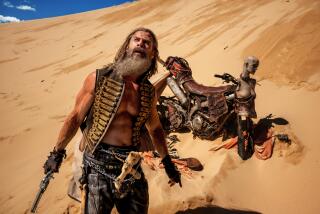Studio counts on ‘Fast’ bucks
Most people in Hollywood are bad at math, which is probably why actors are so wildly overpaid and movie budgets are always spiraling out of control. But in what other business could you possibly write the following equation: 0 x 0 x 0 x 0 = $100 million-plus? Or to make it a word problem: Is it possible to take four actors whose careers are virtually in commercial eclipse, throw them together in the same film and have movie marketers predicting the picture will be a big box-office success?
That’s the odd Hollywood math behind “Fast & Furious,” which opens this weekend. This is the fourth installment of the franchise, and it features Vin Diesel, Paul Walker, Michelle Rodriguez and Jordana Brewster, the stars of the original 2001 hit, all of whose careers have been skidding in recent years. Since the release of “XXX” in 2002, Diesel has had only one film -- the 2005 kiddie comedy “The Pacifier” -- that made more than $60 million. His most recent action film, “Babylon A.D.,” was a flop.
Although he was a major presence in the successful 2006 dog-sled drama, “Eight Below,” Walker has seen his career fade so badly that two of his most recent films, “The Death and Life of Bobby Z” and “The Lazarus Project,” never had a U.S. theatrical release. Rodriguez was in the hit film “S.W.A.T.” way back in 2003, but since then she’s gotten far more attention for her DUI charges than for her film-TV career -- her 2006 film “The Breed” went straight to DVD. Ditto for Brewster, who except for her appearance in the 2006 horror film “Texas Chainsaw Massacre: The Beginning,” has been relegated to roles in a host of little-seen films.
So why all the high anticipation surrounding a “Fast & Furious” reunion? Universal Pictures, which has distributed the entire series of films, can barely contain its excitement. And even rival marketers are predicting an impressive $40 million-plus opening weekend for the new film. First, the film -- which I saw at a recent screening -- plays like gangbusters, offering young moviegoers a huge adrenaline rush with a series of high-velocity car races and chase scenes, beginning with a dazzling oil-tanker hijacking sequence that is the epitome of old-school action. It’s crammed with daring stunts without any antiseptic visual-effects trickery. The acting is forgettable, the dialogue is flat and Diesel -- who is on a quest to avenge his girlfriend’s death -- spends most of his time coaxing information out of bad guys either by beating them to a pulp or hanging them by their feet out of a window.
But if I were 16, I’d want to see the movie again tomorrow. In addition to its vivid action sequences, it deftly captures the exotic glamour of the underground car culture -- the hot whips (as the kids call them these days) are lighted and caressed by the camera as if they were ‘40s Hollywood femme fatales. After a while, you even warm up to Diesel, who plays a surly, Robert Mitchum-style tough-guy, rarely uttering more than one line of dialogue at a time. When he corners a nasty thug praying at the altar in an ancient Mexican church, before he dispatches him, he sneers: “You ain’t forgiven.”
Still, how is it possible that Diesel and Co. have such heat in this film and so little buzz everywhere else? Universal marketing and distribution chief Adam Fogelson argues that the new film is a testament to the enduring appeal of a successful brand. “In the last few years, we’ve seen over and over again the power of movie brands, especially when those brands return to the essence of what made them successful when they started,” he says, citing as examples the popularity of such revived film series as “Rocky,” “Die Hard” and “Friday the 13th.”
Fogelson adds: “People love these actors as these characters. The actors have all gone off in interesting directions, with different career paths, but they have a special appeal playing these roles. It’s not so different from seeing Bruce Willis in ‘Live Free or Die Hard.’ Until that movie, you weren’t sure what his box-office power was. But when he was in a film that looked like a worthy successor to the previous ‘Die Hard’ hits, people got excited again.”
Initially, Universal wasn’t sure of how to handle a fourth film in the series. The first film, released in 2001, had been a surprise hit, making $206 million worldwide. The sequel, made with Walker but without Diesel, made less money in the U.S. but more overseas. However, the third film, “The Fast and the Furious: Tokyo Drift,” with an entirely different cast, fell off considerably, making only $62 million in the U.S., with an additional $95 million overseas. Even though profits were down, costs were up, since the first film was budgeted at $40 million, while the sequel cost $90 million and the third in the series came in at around $85 million.
According to producer Neal Moritz, at the helm of the entire series, the first hint of a renewed interest in a cast reunion came when -- as something of a marketing gimmick -- Diesel showed up in a cameo at the end of the third film. The reaction was intense. “The audience just levitated,” Fogelson says. At first, Moritz says, he had screenwriters working on a “Fast and Furious” spin-off featuring Diesel’s Dominic Toretto character.
“But while we were working on that, we got the big idea -- what if we got everyone back together, sort of a new model with the original parts,” he explains. “It really hadn’t been done before with an ensemble film, but we thought it could work because it was something audiences wanted to see, and obviously it gave us a great marketing hook to sell the picture.”
Moritz brought in Chris Morgan, who wrote the “Tokyo Drift” installment in the series (he also wrote last summer’s action hit “Wanted”). Morgan was forced to work at a breakneck pace, trying to finish the script before the writers strike. “We basically had a start date without a finished script,” Moritz recalls. “For almost a month, Chris and the rest of us were cooped up in conference rooms at Universal, often working past midnight almost every night, trying to finish the script before the strike deadline.”
Justin Lin, the film’s director (who also did “Tokyo Drift”), mapped out the action scenes and car races in the old-fashioned way, literally starting by steering toy cars around a table top. “Justin would sit there for hours, with these Hot Wheels cars, moving them around on tables with streets and hills drawn on them, working with our storyboard artists, seeing how everything might work,” Moritz says. “We’d film the toy car sequences, then we’d storyboard it, then we’d do CGI pre-[visualization] to see what would it look like. Everyone offered comments, we’d revise it, then figure out how to actually shoot it.”
The new film isn’t cheap -- it cost nearly $100 million to make. But it already has the kind of buzz that buoys hit movies. The film’s first trailer created a wave of fan interest, using the oil tanker hijacking footage to establish the movie’s action bona-fides, then revealing the presence of the original cast. The film was originally slated for release in June, but after a pair of enthusiastic test screenings this year, the studio decided to move up the release to this weekend.
“They saw an opening where they’d be the only action movie in the market over the entire spring break,” Moritz says. “Kids are all out of school, so it’s a lot like summer, except with a lot less competition, since you don’t have to go up against big guns like ‘Transformers,’ ‘Star Trek’ or ‘Night at the Museum.’ ”
Filmmakers are often wary about showing too much optimism for their opening weekend these days, but not Moritz, who just returned from a European promotional tour for the film. “We had premieres in Paris, London, Madrid, Moscow and Rome,” he says. “We were mobbed everywhere we went. Everybody wants to see these actors in this film again. It’s an idea whose time has come.”
--
More to Read
The biggest entertainment stories
Get our big stories about Hollywood, film, television, music, arts, culture and more right in your inbox as soon as they publish.
You may occasionally receive promotional content from the Los Angeles Times.










